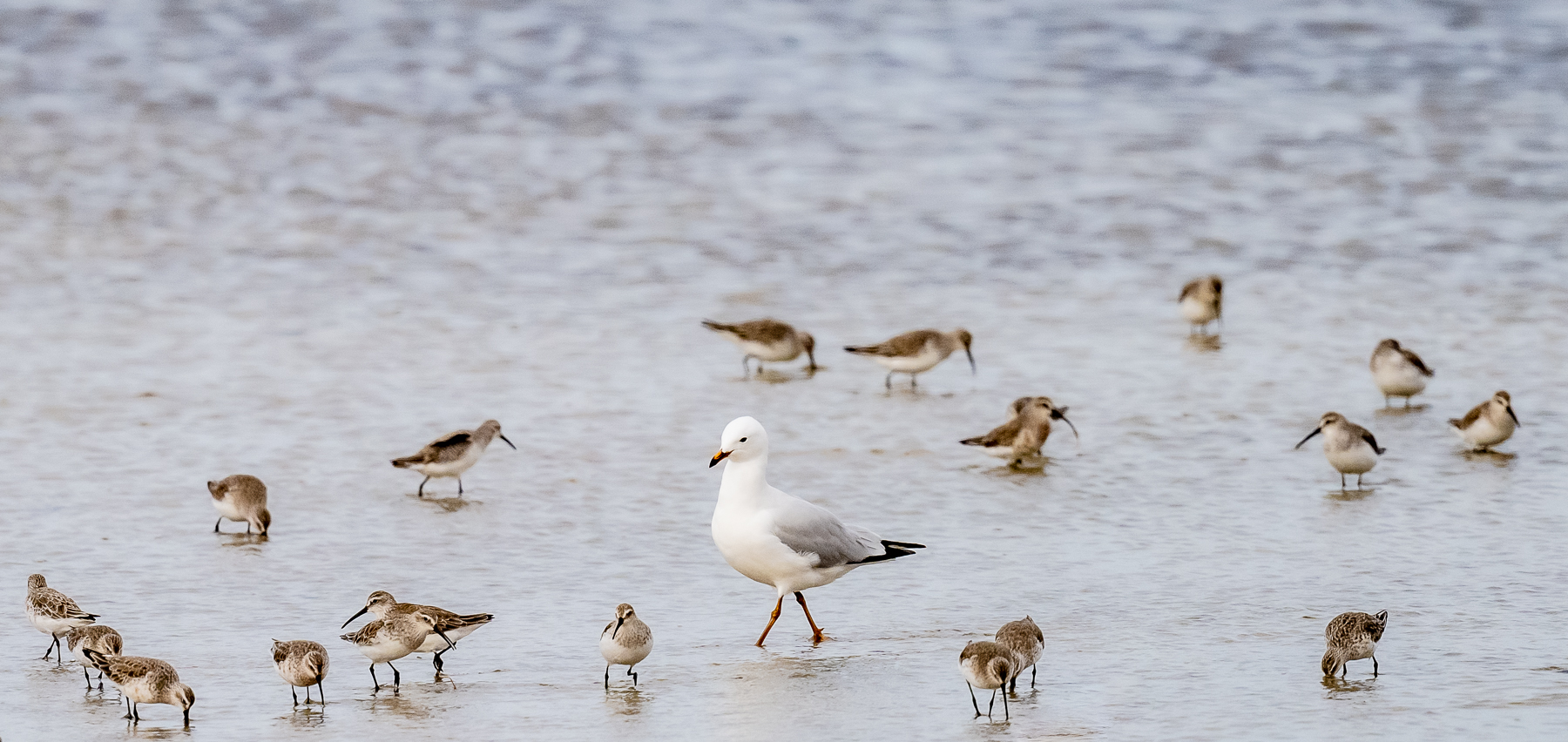
Inspiring and Supporting Photographers of Australian Birds
Curlew Sandpiper, Silver Gull
 | |||||||||||||||||||||||||
| Photographed by | Michael Hamel-Green on Tue 13th Jul, 2021 and uploaded on Fri 20th Aug, 2021 . | ||||||||||||||||||||||||
| Resolution | 1800x852 | ||||||||||||||||||||||||
| Viewed | 142 | ||||||||||||||||||||||||
| ID | 47684 | ||||||||||||||||||||||||
| Comment | These Curlew Sandpipers were feeding in shallow water as the tide receded on the Werribee Treatment Plant shoreline. They were joined by an immature Silver Gull (still with some black in its beak, and dark legs, most likely a 2-year old). The Curlew Sandpipers are mainly juveniles who stay behind over two Australian winters while their intrepid parents leave around April for their annual epic 13,000 km journeys to their Russian Arctic breeding grounds: Chosha Bay east to Kolyuchiskaya Bay, the Chukchi Peninsula, and the New Siberian Islands. And about now, July to August, the parents begin their return trip to Australia via the East Asian-Australasian Flyway, arriving at Werribee and other Australian coastal stretches over August and September. Hopefully, lockdowns permitting, I will see the returning adult Sandpipers on my next Werribee visit. I will certainly look at these amazingly resilient birds with renewed awe and respect: tiny bundles of feathers, with down-curving beaks, grey wings, and black feet, who have just flown to the other side of the globe and back, some 26,000 km in a mere six months, facing so many terrors along the way…extreme weather events, hunters, environmental pollution, predators, reduced river flows, sea-level rise, wetland degradation, and coastal urban and industrial expansion. It is little wonder that all these multiplying threats are having a devastating impact on Curlew Sandpiper populations. Over a 23-year survey period to 2008, numbers visiting Australia declined by 50%-70% (http://www.environment.gov.au/biodiversity/threatened/species/pubs/856-conservation-advice.pdf). They are now listed as critically endangered in Victoria and many other parts of Australia. The youngster Silver Gull, of course, has a somewhat less demanding life ahead of it, although apparently even gulls in neighbouring New Zealand are now in decline due to agricultural practices. Silver Gulls, of course, have turned scavenging into a fine art, perhaps driven to this by reduced fish availability in seas and inland waters, and are also, sadly, prone to stealing food and eggs from other birds. Hope this is not why Curlew Sandpipers feel they have to travel to the other side of the globe to hatch their eggs. | ||||||||||||||||||||||||
| Equipment | Nikon Z7ii, Nikon 500mm PF f5.6 ISO 800 1/4000th f6.3 | ||||||||||||||||||||||||
| Location | Werribee Treatment Plant, Werribee, Victoria | ||||||||||||||||||||||||
| Keywords | non-breeding plumage/features | ||||||||||||||||||||||||
| You already have an outstanding request to download this image for non-commercial purposes. You may cancel this request by clicking on the button below and waiting for confirmation that your request has been noted. When you have selected all the images that you require, go to 'My Download Requests' (under Photo Gallery) and submit your request by clicking 'Edit/Submit' and filling out the details. You will be advised of the result by email. Note that cookies MUST be enabled for this to work. | |||||||||||||||||||||||||
| You may request download of this image for non-commercial purposes. A request that meets the usage rights of this image will be automatically approved; a request that does not meet the usage rights will be refused, but may (at the Download Manager's discretion) be referred to the photographer. The usage rights of this image are: Any non-commercial use by any requestor, including personal use. For further details of image usage rights, see here. Request the image by clicking on the button below and waiting for confirmation that your request has been noted. When you have selected all the images that you require, go to 'My Download Requests' (under Photo Gallery) and submit your request by clicking 'Edit/Submit' and filling out the details. You will be advised of the result by email. Note that cookies MUST be enabled for this to work. | |||||||||||||||||||||||||
| COMPUTED.html: width="1800" height="852" COMPUTED.Height: 852 COMPUTED.Width: 1800 COMPUTED.IsColor: Not printable COMPUTED.ByteOrderMotorola: Not printable COMPUTED.ApertureFNumber: f/6.3 COMPUTED.Thumbnail.FileType: Not printable COMPUTED.Thumbnail.MimeType: image/jpeg IFD0.Make: NIKON CORPORATION IFD0.Model: NIKON Z 7_2 IFD0.XResolution: 10000/centimeters IFD0.YResolution: 10000/centimeters IFD0.ResolutionUnit: centimeters IFD0.Software: Adobe Photoshop Lightroom Classic 10.2 (Macintosh) IFD0.DateTime: 2021:08:20 11:20:37 IFD0.Exif_IFD_Pointer: Not printable EXIF.ExposureTime: 1/4000 EXIF.FNumber: F6.3 EXIF.ExposureProgram: Aperture priority EXIF.ISOSpeedRatings: 800 EXIF.UndefinedTag:0x8830: Not printable EXIF.UndefinedTag:0x8832: 800 EXIF.ExifVersion: 0231 EXIF.DateTimeOriginal: 2021:07:13 12:46:41 EXIF.DateTimeDigitized: 2021:07:13 12:46:41 EXIF.UndefinedTag:0x9010: +10:00 EXIF.UndefinedTag:0x9011: +11:00 EXIF.UndefinedTag:0x9012: +11:00 EXIF.ShutterSpeedValue: 11.965784 EXIF.ApertureValue: F5.3 EXIF.ExposureBiasValue: 0.33333333333333 EXIF.MeteringMode: CenterWeightedAverage EXIF.LightSource: unknown EXIF.Flash: Flash did not fire. EXIF.FocalLength: 500mm EXIF.SubSecTimeOriginal: 33 EXIF.SubSecTimeDigitized: 33 EXIF.ColorSpace: Not printable EXIF.FocalPlaneXResolution: 2301.3246154785 EXIF.FocalPlaneYResolution: 2301.3246154785 EXIF.FocalPlaneResolutionUnit: Not printable EXIF.SensingMethod: Not printable EXIF.FileSource: DSC EXIF.SceneType: Not printable EXIF.CFAPattern: Not printable EXIF.CustomRendered: Not printable EXIF.ExposureMode: Automatic Exposure EXIF.WhiteBalance: Automatic White Balance EXIF.FocalLengthIn35mmFilm: 500 EXIF.SceneCaptureType: Unknown EXIF.GainControl: Not printable EXIF.Contrast: Not printable EXIF.Saturation: Not printable EXIF.Sharpness: Not printable EXIF.SubjectDistanceRange: Not printable EXIF.UndefinedTag:0xA431: 7400275 EXIF.UndefinedTag:0xA432: Not printable EXIF.UndefinedTag:0xA433: NIKON EXIF.UndefinedTag:0xA434: AF-S NIKKOR 500mm f/5.6E PF ED VR EXIF.UndefinedTag:0xA435: 224543 | |||||||||||||||||||||||||
| |||||||||||||||||||||||||
CONTACT US
The easiest way to contact us is by emailing us at This email address is being protected from spambots. You need JavaScript enabled to view it.
The Our People page, in the About Us section, contains email links to each of the committee members.
Copyright © BirdLife Photography 2016-23. Website design and programming by This email address is being protected from spambots. You need JavaScript enabled to view it. and This email address is being protected from spambots. You need JavaScript enabled to view it.. Website Administrator: This email address is being protected from spambots. You need JavaScript enabled to view it..


